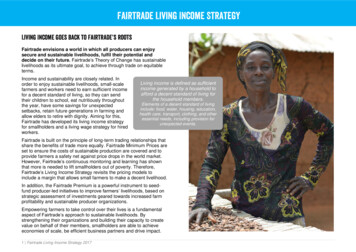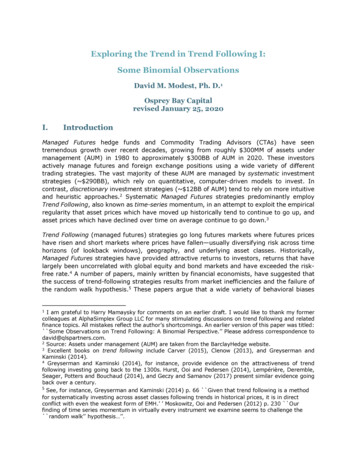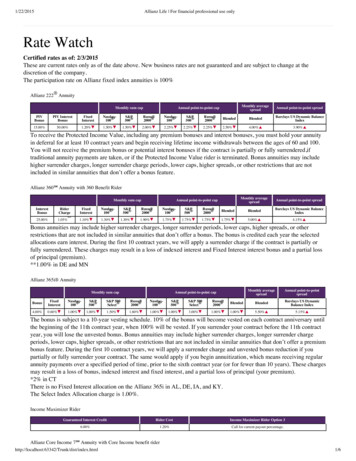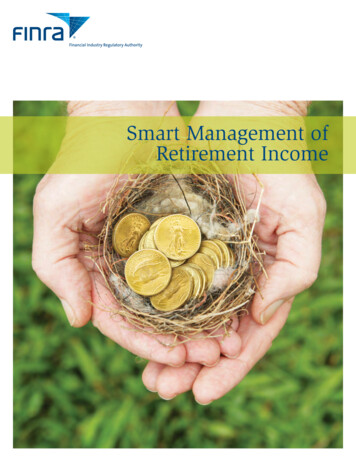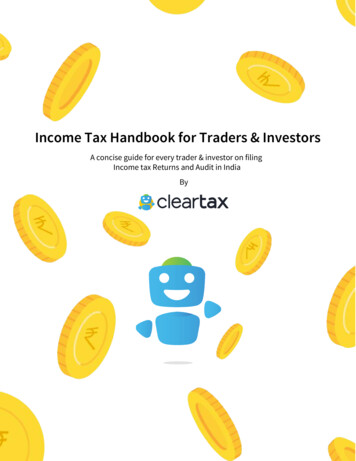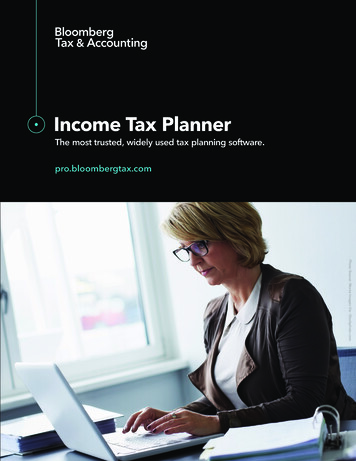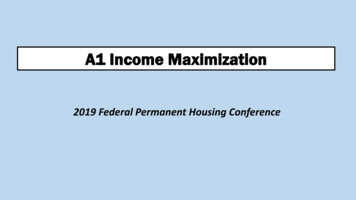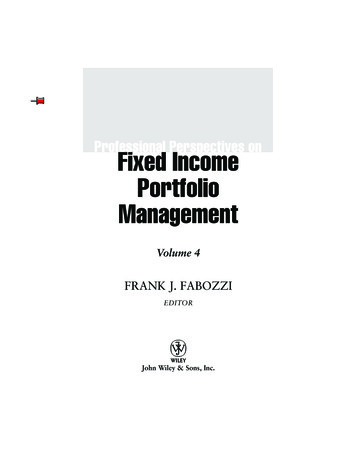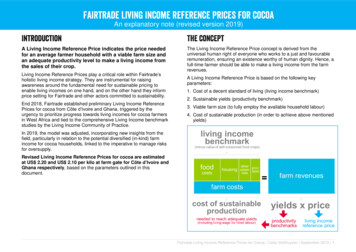
Transcription
Fairtrade Living Income Reference Prices for CocoaAn explanatory note (revised version 2019)IntroductionThe conceptA Living Income Reference Price indicates the price neededfor an average farmer household with a viable farm size andan adequate productivity level to make a living income fromthe sales of their crop.The Living Income Reference Price concept is derived from theuniversal human right of everyone who works to a just and favourableremuneration, ensuring an existence worthy of human dignity. Hence, afull-time farmer should be able to make a living income from the farmrevenues.Living Income Reference Prices play a critical role within Fairtrade’sholistic living income strategy. They are instrumental for raisingawareness around the fundamental need for sustainable pricing toenable living incomes on one hand, and on the other hand they informprice setting for Fairtrade and other actors committed to sustainability.End 2018, Fairtrade established preliminary Living Income ReferencePrices for cocoa from Côte d’Ivoire and Ghana, triggered by theurgency to prioritize progress towards living incomes for cocoa farmersin West Africa and tied to the comprehensive Living Income benchmarkstudies by the Living Income Community of Practice.A Living Income Reference Price is based on the following keyparameters:1. Cost of a decent standard of living (living income benchmark)2. Sustainable yields (productivity benchmark)3. Viable farm size (to fully employ the available household labour)4. Cost of sustainable production (in order to achieve above mentionedyields)In 2019, the model was adjusted, incorporating new insights from thefield, particularly in relation to the potential diversified (in-kind) farmincome for cocoa households, linked to the imperative to manage risksfor oversupply.Revised Living Income Reference Prices for cocoa are estimatedat US 2.20 and US 2.10 per kilo at farm gate for Côte d’Ivoire andGhana respectively, based on the parameters outlined in thisdocument.Fairtrade Living Income Reference Prices for Cocoa Carla Veldhuyzen September 2019 1
FairtradeLiving Income Reference Prices for CocoaFairtrade Living IncomeStrategyA price that allows an average farmer household with a viable farm sizeand a sustainable productivity level to earn a living income can thus becalculated with the formula: price x volumes produced cost of decentliving cost of production, or:In this model, the value of food produced on the farm for homeconsumption is considered an important source of in-kind income, thatreduces the cost of decent living.Otherwise, for calculating the reference price we focus on the Fairtradecrop as our sphere of influence. Although crop diversification is stronglypromoted, the formula is based on cocoa as a single cash crop,assuming that any other farm activity would be as profitable as cocoaand thus generate a proportionate share of a living income.Parameter 1: Living Income benchmarksLiving income is defined as sufficient income generated by ahousehold to afford a decent standard of living for the householdmembers. Elements of a decent standard of living include: a nutritiousdiet, water, decent housing, education, healthcare, transport, clothingand other essential needs, including a provision for unexpected events.Comprehensive living income studies, based on the Ankermethodologyiv, calculated the cost of decent living at US 2.16 perperson per day in Ghana and US 2.49 per person per day in Côted’Ivoire.For a typical six-member household in Ghanav, this would result in aliving income benchmark of US 4,730 per year, of which US 2,448are food costs.Establishing Living income Reference PricesIn order to establish Living Income Reference Prices for cocoa in WestAfrica, values for each of the parameters were determined. The initialvalues were estimated based on findings from Fairtrade’s householdincome study in Côte d’Ivoirei, complementary research into realistic,sustainable productivity targets and the associated costs of productionby New Foresightii, living income benchmark studies by the LivingIncome Community of Practiceiii as well as consultation with keystakeholders, including Fairtrade cocoa farmers in Ghana and Côted’Ivoire, traders, licensees, research institutes, NGOs and civil societyactors.New insights concerning the potential for additional farm income beinggenerated on land under rehabilitation, among other minor aspects,have led to revised Living Income Reference Prices in 2019 asexplained hereafter.Similarly, a typical household with eight members in Côte d’Ivoireviwould need US 7271 per year to cover their cost of a decent living, ofwhich US 3,490 are food costs.Fairtrade Living income Reference Prices for Cocoa Carla Veldhuyzen September 2019 2
FairtradeLiving Income Reference Prices for CocoaFairtrade Living IncomeStrategyParameter 2: Sustainable yieldsAdequate productivity levels are determined based on feasibleyields, obtained when implementing sustainable agriculturalpractices. These are called productivity benchmarks.New Foresight was commissioned to investigate feasible productivitylevels in Côte d’Ivoire and Ghana, by reviewing literature, interviewingexperts and conducting workshops with Fairtrade lead farmers in bothcountries. Although they found that yields of 1,500 kg/ha would bepossible, these would only be achievable in the long term and underfavourable conditions (such as timely availability of good qualityseedlings and agricultural inputs, access to finance, etc.).The cost of a nutritious diet makes up for approximately half the livingcost. Food produced on the farm for home consumption is consideredas in-kind income and can be deducted from the financial cost of living,as it reduces the food expenditure of the household.Research findings, including the extensive “Demystifying Cocoa”household study by the Royal Institute of the Tropics (KIT)vii and privatesector data, as well as direct farmer feedback, indicate that a largeshare of household food needs is - or could be - produced on farm.These food crops are generally grown alongside cocoa andcompensate for unproductive years in areas where cocoa trees havebeen newly replanted as part of rehabilitation efforts.Consultation among Ivorian farmers confirmed that it is realistic to aimfor fifty percent of a nutritious diet, valued at US 1,745, beingproduced on farm. Less land is available for growing food crops inGhana and therefore the target value of farm produced food is set at aquarter of the total food needs or US 612.Hence, the financial cost of decent living is brought down to US 4,118and US 5,526 for Ghana and Côte d’Ivoire respectively.In consultation with West African producers, 800 kg/ha was considereda more realistic benchmark under current circumstances. Forcomparison, the average yield in Côte d'Ivoire was 437 kg/ha and only2% of the surveyed households in 2016 obtained yields per hectare of1,000 kilos or more.viiiA productivity benchmark of 800 kg/ha was put forward forconsultation. Although some stakeholders expressed their doubts aboutthe feasibility of these yields, the majority of the producers andtechnical experts from the cocoa industry confirmed this to be a realistictarget yield that can be achieved in the medium term. Moreover, it is inline with Ghana COCOBOD’s productivity target. This feedback wasdecisive to maintain the proposed productivity benchmark.Nonetheless, it is important to acknowledge the temporary ban onproductivity enhancement projects by the Ivorian Conseil du CaféCacao, while it is taking stock of the country’s current cocoa production.This will limit farmers’ possibilities to achieve the target yield in theshort term.Some concerns were also raised around agro-ecological productionpractices not being taken into consideration. Further research isneeded to determine whether similar yields are achievable throughadoption of agro-ecological production techniques.Fairtrade Living income Reference Prices for Cocoa Carla Veldhuyzen September 2019 3
FairtradeLiving Income Reference Prices for CocoaFairtrade Living IncomeStrategyParameter 3: Viable farm sizeParameter 4: Cost of ProductionThe Universal Declaration of Human Rights establishes: “Everyonewho works has the right to just and favourable remuneration ensuringfor himself and his family an existence worthy of human dignity.”Hence, hired workers have the right to a living wage and self-employedfarmers should be able to make a living income from their farmproceedings. Following this guiding principle, a farm that is bigenough to fully absorb the available household labour, shouldgenerate a living income. This would be considered a viable farm sizeor a ‘full-employment farm size’.The costs associated with a productivity of 800 kg/ha are higher thanthe actual production costs, since the current low yields can beattributed to insufficient farm investment. In order to project the farmbusiness costs involved in producing 800 kg/ha, the following main costitems are considered:A viable cocoa farm size in Côte d’Ivoire was established at 5.3hectares, based on 3 full-time breadwinners, of which 2.5 full-timeequivalent dedicated to cocoa farming. Similarly, a typical six-memberGhanaian household with 2.25 full-time breadwinners would need fourhectares to fully employ their available labour force.Ivorian households typically own, or have access to, additional plots ofland where they grow some food or other cash crops, occupying theremaining household labour. This is not the case for Ghana.Allowing for continuous crop renovation needed to maintain the cocoatrees optimally productive, implies that part of the land is alwaysunproductive. Considering a 28-year life cycle of cocoa treesix with zeroproduction during the first three years, 15% productivity in the next 2years and full production for the following 23 years, the productivecocoa area represents 83% of the total cocoa area. Non-productivecocoa area is assumed to be used for food production as in-kindincome.Therefore, we set a productive cocoa area of 4.4 / 3.3 hectares forCôte d’Ivoire / Ghana respectively.The cost of production, however, is based on the full 5.3 / 4hectares, also covering the labour incurred in growing food, whichcompensates the lower investment needed in cocoa during theunproductive years. Fertilizer: Seven bags of fertilizer are required per hectare ofproductive cocoa to reach the target yield of 800 kg/ha, whereasrenovated areas don’t need more than one bag. The non-subsidizedfertilizer price is around US 31.50 per bag, resulting in a cost ofUS 221 per hectare of productive cocoa and US 31.50 perhectare of land under rehabilitation. However, in Ghana, fertilizersand other inputs for cocoa production are heavily subsidized and abag of fertilizer is factored in at a reduced cost of US 25. Other agricultural inputs: A lump sum equal to 40% of the fertilizercosts for pesticides and other inputs was put forward forconsultation. Feedback received from producers showed largevariances, ranging from agreement with the proposed value to morethan double. Until more accurate data become available, a slightincrease to US 80/ha for Côte d’Ivoire and US 70/ha for Ghana isapplied to cover other inputs on productive land, plus an additionalUS 47/ha to pay for seedlings. Labour: Approximately 125 labour days per hectare per year areneeded to produce 800 kg/ha. Most of this work is expected to bedone by household members and is not included in the cost ofproduction. Besides the household labour, a 5.3 hectare farm inCôte d’Ivoire would need approximately 62 hired labour days peryear and a Ghanaian 4 hectare farm would have to hire 47 mandays. These are factored in at living wages. This way, thereference price covers a living income for the farmer household(provided the available household labour is effectivelyemployed on their farm) from the cocoa profits and a livingwage for hired workers.Fairtrade Living income Reference Prices for Cocoa Carla Veldhuyzen September 2019 4
FairtradeLiving Income Reference Prices for CocoaFairtrade Living IncomeStrategyAssuming comparable household compositions for rural workers andfarmers, proxy living wages are estimated based on the LivingIncome benchmark study results, at US 9.24 per day in Côted’Ivoire and US 8 per day in Ghana. Fixed costs: A fixed amount of US 250 for an average Ivorian farmand US 200 for a Ghanaian farm is included to cover investmentsin tools, equipment and infrastructure, as well as farm administrativecosts.The above farm cost items add up to a total cost of sustainableproduction of US 2216 and US 1431 for a viable farm size in Côted’Ivoire and Ghana respectively, or US 418 / 358 per hectare.The cost of production is added to the living income benchmark, inorder to calculate the total farm revenues needed to afford a decentliving and make the necessary investments in the farm.Adjusted Living Income Reference Prices 2019Implementing Living income Reference PricesBy establishing Living Income Reference Prices, Fairtrade quantifiesthe gap between market and sustainable prices at farm gate level andemphasizes the need to address price as a crucial factor to attainsustainable supply chains that enable farmers to earn a living income.The price gap is large and it will take considerable effort andcommitment from the entire industry to make living incomes possible.The increased Fairtrade Minimum Price for cocoa, entering into forceper October 1st 2019, is a first step in a gradual approach to bridge theprice gap. Applying today’s differential of nearly US 800 between farmgate and free on board (FOB) prices, as per regulated price breakdownin Côte d’Ivoirex, the Fairtrade Minimum Price at FOB would have to beUS 3,000 per tonne to result in a farmer price that equals the LivingIncome Reference Price. Hence, a Minimum Price increase from US 2,000 to US 2,400 per tonne closes 40% of the price gap.The adjusted parameter values lead to Fairtrade Living IncomeReference Prices of US 2.20 per kilo of cocoa at farm gate forCôte d’Ivoire and US 2.10 per kilo for Ghana, as follows:The lower reference price for Ghana can be attributed to a relativelylower cost of decent living per person, as well as the subsidized costsof production.Figure 1: Fairtrade living Income Reference Price for Côte d’Ivoire in relation to theFairtrade Minimum Price and historical world market pricesFairtrade Living income Reference Prices for Cocoa Carla Veldhuyzen September 2019 5
FairtradeLiving Income Reference Prices for CocoaFairtrade Living IncomeStrategyAn average Ivorian household would need to receive US 1,438 permetric tonne at farm gate to reach the World Bank’s extreme povertyline.xi The Fairtrade Minimum Price increase allows cocoa farmers toescape extreme poverty with current yields.welcome level playing field for the industry to address low cocoa pricesat scale.Fairtrade will integrate voluntary payment of the Living IncomeReference Prices in living income pilot projects with committed, forwardlooking, commercial partners. By implementing the holistic livingincome strategy on a controlled scale, Fairtrade seeks to demonstrateits effectiveness and validate the price component as a critical driver toachieve living incomes.In this, Fairtrade recommends that the Fairtrade Premium is paid on topof the LIRP. The Fairtrade Premium is an important (and in Ghanaoften the only) source of income for cooperatives to cover their costs tooperate and provide the services to support their members reach targetyields, cost efficiency and farm resilience, which are equally needed toachieve living incomes.Further steps in terms of raising the mandatory Fairtrade MinimumPrice and/or introducing other price mechanisms will be based oncareful evaluation of the impact of before-mentioned price interventionson market acceptance and the incomes of cocoa farmers.The Living Income Reference Price model makes up an integral part of Fairtrade’sLiving Income Strategy. Fairtrade is constantly testing and improving its model inorder to develop a standardized approach for establishing sustainable price levelsfor smallholder farmers, applicable to a wide range of commodities and regions.We welcome your feedback in this process.Figure 2: Income scenarios for Côte d’Ivoire with different price and yield levels inrelation to poverty lines and living incomeStarting the harvest season 2020/21, the Ghanaian and Ivoriangovernments have jointly announced to go a step further. Theintroduction of a Living Income Differential (LID) of US 400 per tonneon top of the FOB price and its consequent guarantee of a minimumprice of US 1,820 per tonne for a cocoa farmer at farm gate creates aiCocoa Farmer Income, Fairtrade International, 2018Assessing Living Income from cocoa, New Foresight, 2017iiiLiving Income Reports Rural Ghana / Côte d’Ivoire, Living Income Community of Practice, -methodologyvRoyal Tropical Institute Gap analysis, Bymolt, Laven & Tyzler, 2018viCocoa Farmer Income, Fairtrade International, 2018viiDemystifying cocoa, Bymolt, Laven & Tyzler, 2018viiiCocoa Farmer Income, Fairtrade International, 2018iiFor more information or comments, please contact:Carla Veldhuyzen van Zanten Senior Advisor Sustainable Livelihoods icable for harvest season 2018/19.xiThe World Bank’s extreme poverty line is set globally at US 1.90 per person per day. Byapplying the Purchasing Power Parity rate for Cote d’Ivoire, this converts into 78 dollar cents perperson per day or US 2,276 on an annual basis for an 8-member household. With the currentaverage yield of 437 kg/ha, productive farm area of 5.3 hectare and production costs of US 200/ha, a farm gate price of US 1,438 per tonne is minimally needed to reach the extremepoverty line.Fairtrade Living income Reference Prices for Cocoa Carla Veldhuyzen September 2019 6
A Living Income Reference Price indicates the price needed for an average farmer household with a viable farm size and an adequate productivity level to make a living income from the sales of their crop. Living Income Reference Prices play a critical role within Fairtrade’s holistic living
